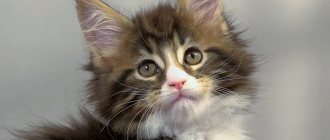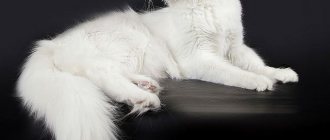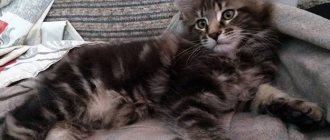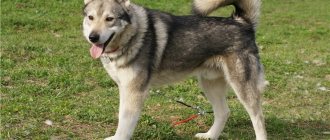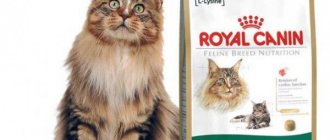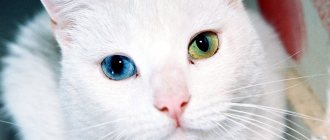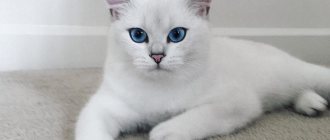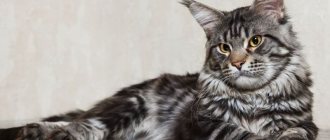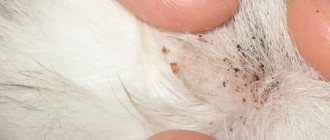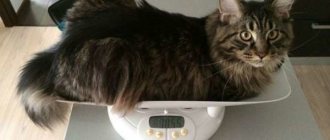Siamese cat: breed type, color and pet care
The origin has deep roots.
The homeland of this breed is the kingdom of Siam (hence the name Siamese cat), present-day Thailand. Along the Silk Road it was brought to the territory of Asian countries, then to Africa and to European countries. This event happened more than 600 years ago. The ancestors of Siamese cats were representatives of the Bengal breed. Throughout the history of their existence, there have been many crossings with domestic animals of various European breeds, but despite this diverse mixture, they have retained their original features characteristic of the Siamese.
The breed standard was approved at the beginning of the 20th century. This event took place at the British Cat Club.
Description of the breed
Loyal, friendly and capricious, the oriental beauty has a flexible, but at the same time muscular body. She is slender and graceful, attracting with her special charm and uniqueness.
- The head is medium-sized and wedge-shaped.
- Refined long neck.
- The ears are medium-sized, triangle-shaped, slightly pointed at the tips.
- The eyes are oval-shaped and medium in size. Eye color – rich blue.
- Slightly elongated body, with short and shiny hair, close-lying.
- A distinctive feature of the Siamese breed is a cute mask on the face.
- Slender paws of medium size, oval at the tips. The length of the hind limbs is slightly greater than that of the front legs.
- The tail is long, tapering at the end.
- The average weight of representatives of this breed is 5-6 kg.
Coat color
At birth, Siamese kittens have a white coat and a cute nose with a pink tint. Over the course of a year, the color of the coat changes, gradually taking on the color characteristic of this breed.
The traditional coat color is a monotonous, cream or snow-white shade with the obligatory markings that create the image of a mask.
Acceptable coat colors for Siamese:
- coffee with milk;
- grey;
- “lilac” - with a pinkish tint and smoky marks;
- “sil” - there are black and brown markings on the muzzle, paws, ears and tail;
- “tabby” - assumes a light coat color with the obligatory striped inserts;
- “red” is a peach or golden-red tint of the coat.
The Siamese cat's eyes are exclusively blue, although the color can vary from light tones to a rich blue color.
a brief description of
Siamese cats are independent and temperamental, have a hunting instinct and are a bit stubborn. Little kittens need attention and love. Adults are more likely to accept affection depending on their mood, but in general, this breed is very friendly, loyal and sociable. Siamese cats quickly become attached to their owner and home, and throughout their entire lives they remain faithful and devoted to their new family.
Unlike other domestic cats, Siamese representatives do not recognize other animals in the house and are wary of them. They often show feelings of jealousy. Oriental beauties prefer to be in first place and do not want to share the owner’s attention with other four-legged representatives.
A Siamese cat should also not be owned by a family with small children. This breed has a very characteristic character, and if a child offends the animal or pulls it often, it can show its independent character and scratch the baby.
Character traits
Cats of this breed are self-sufficient and love to be the center of attention. Disapproving of being around other cats, they often suffer when the owner leaves her alone for a long time. Siamese pets need the company of people. Upon returning home, it is advisable to pay extra attention to your four-legged friend, because he has been waiting for this for so long!
Siamese cats are quite energetic and active. They love to play outdoor games with their owner. This breed is also often characterized as "chatty". Cute pets love to grumble and complain. They express their requests loudly and persistently.
The Siamese breed is easy to train. Cats can be trained and taught different tricks. They perform well the typical commands for dogs: “sit”, “lie down”, “fetch”, “give me a paw”, etc.
Siamese are intelligent, but at the same time touchy. If you punish a cat unfairly or yell at it, it will remember this gesture for a long time and will harbor a malicious grudge. When raising a purebred pet, it is necessary to use tact and calmness, otherwise you will not be able to make friends with this beautiful animal.
Breed variety:
- The Neva Masquerade cat is a mix of Siamese and Siberian breeds.
- Royal Siamese cat.
- Thai beauty with more rounded contours.
- Oriental breed.
- Mekong Bobtail.
Read our other articles to see what a mixed breed cat looks like!
Siberian breed and Neva masquerade cat - how it happened
The name “Siberian cat” has been used in Russia for quite a long time; back in the 17th and 18th centuries, this was the name given to large, fluffy, striped cats. Why were these cats associated with Siberia? Probably because for Russian people Siberia was still a somewhat wild land, full of animals, birds, a region with harsh weather conditions - severe frosts, long winters. It was this image of Siberia that most suited the population of cats with heavy bones, long hair, etc. People probably believed that only such cats could survive in Siberia. Images of such cats can be seen in ancient paintings, on popular prints, and they are described in fairy tales, songs, and proverbs. Therefore, when it was allowed to breed cats in Soviet Russia, it was the image of the fluffy tabby cat that was taken as the basis for the Siberian breed. Under Soviet rule, there were no cat shows in the USSR and there were no clubs that would engage in breeding work with cats. Of course, Soviet people heard about the fabulously expensive Persian cats, many heard that there are fluffy white cats - “Angorkas”, fluffy cats with a tabby pattern (usually black tabby) were called “Siberian”.
At the end of the 60s, the artist Obraztsov brought the first “Siamese” cats to Moscow. Of course, these were animals without pedigrees, just domestic Siamese cats. The first cat show in the USSR in 1987 was a shock, a bomb! People stood in line for 5-6 hours to see... two or three Persians from the Czech Republic, several short-haired cats, a sea of fluffy domestic Vasek and Murok. But a commission of enthusiasts (dog club instructors, journalists, veterinarians, just enthusiasts) tried to find each cat its own breed: Angoras, Siamese, Russian Blues, and, of course, Siberians were determined to be purebred cats. There is no need to condemn and criticize them - they were the first who decided to bring cats out of basements and prove that these animals are worthy of respect and love. After the exhibition, clubs began to form, exhibitions were held, and experts were invited. The first judges at cat shows in the USSR (under the auspices of FIFe) were Czechs (B. Mahelka, I. Kitlerova, J. Knieva, etc.). The contingent of cats that they judged in the 90s was approximately as follows: Persians (from Czechoslovakia, Poland) , units of purebred KSh cats with documents and a mass of semi-long-haired cats and KSh cats of unknown origin. By this time (the time of active exhibitions with examination), enthusiasts of the Siberian breed had already compiled several versions of the standard. It should be noted the invaluable help of prominent Western experts who showed inexperienced clubs the difference in standards between the native cats of Scandinavia, America and Russia. I would like to thank the famous Dutch expert Maas Jean Paul. His extensive experience as an expert in the LDS group of breeds, patience and attention to cats helped us a lot.
So, in the early 90s, there were already standards for the Siberian breed, the differences between the new breed and the Norwegians and Maine Coons were clearly defined, the foundations for breeding were laid, crossing Siberian cats with other breeds was prohibited, and the standard noted important exterior features (coat quality, type). These were truly the golden days of the breed! At exhibitions, Siberians accounted for up to half of the cats! They ended up on Best, the press wrote about them, kittens from nurseries found buyers.
But in parallel with the development of an aboriginal breed of cats of unknown origin, another process was going on. Let us recall that cats of unknown origin, “similar” to Siamese, Russian Blues, Balinese, etc., were bred into “pedigreed” cats. Experts from FIFe and independent clubs tactfully explained to breeders that there is no point in trying to breed “Russian Blues,” “Siamese,” “Balinese,” etc. from outbred cats. Pedigree cats of “cultivated” breeds should be purchased from nurseries, with pedigrees, and engaged in competent breeding, and not reinvent the wheel in Russian. But the fame of “purebred” cats (and the money for sold kittens “with documents”) has already turned the heads of some breeders. How? Admit that their cat is “just a house cat”? Yes, she has a diploma and a rosette from the exhibition! To the credit of the chairmen of many clubs, we will say that many clubs have tried to explain to such owners that the time has come for competent breeding and if they are interested in this, they must purchase cats from nurseries. The first Siamese and Orientals were brought, the first Balinese with a pedigree. Owners of “Siamese” and “Balinese” without the pedigrees identified at the first exhibitions had to leave the stage. But fortunately for them, they found a “niche” for them too. Allegedly, the “Siamese” became the “Thais”; a breed was also found for the “Balinese” - they became the “Neva Masquerade”.
Enterprising breeders even told the story of the origin of the “Neva Masquerade breed” (Brazilian TV series are on vacation!). After the Patriotic War in 1945, Leningrad suffered from an invasion of rats (remember that the city experienced a terrible blockade and famine, all the cats and dogs in the city were eaten! This is one of the most tragic pages of our history). In order to save the beautiful city on the Neva, cats began to be brought to Leningrad by rail in wagons from all over the country - they collected everything they had from cities and towns. But it turns out there were Siberian cats, Siamese cats (!!!!!!!), Persians (!!!!!!), etc. and so on. This is how the breed was formed in Leningrad and this is exactly what it is - a fluffy point-colored cat. The truth is simpler and more prosaic: Persian cats, including colorful ones, were brought to the country in the 90s. Owners of domestic fluffy cats bred their cats with them by hook or by crook and received “half Persians” - smart, large kittens with excellent Persian fur. Such kittens were famously sold at the Bird Market - few could afford a Persian, but such mixed breeds sold well. Then everything is clear - carriers of the Siamese gene mated with each other, according to Mendel's law, LDS cats of Siamese color were produced. This is the first way to form “Neva” - such lines are distinguished by a round head, round eyes, large size, massiveness, and Persian coat structure. Another way of formation of LDS in cats of point colors is from “Thai” cats. Random crossing of imported cats of Siamese color with LDS domestic cats gave the "Neva" of a lighter type - they are more like "Thai Balinese" - a wedge-shaped head, a straightened profile, a more elongated body, the coat is mainly guard hair, often without undercoat. In the pedigrees of such cats (in the 90s), the Balinese breed was indicated.
The standard for Nevskys was adopted under pressure from the Leningrad party of judges and breeders and was actually equal to the Siberian standard. To my deep regret, my protest was a voice crying in the wilderness! I gave arguments and evidence to no avail... It was done. The standard was adopted at a meeting of Russian clubs (various systems). Nevertheless, the position of the IFA (International Felinological Association) remains the same. The IFA considers the Neva Masquerade cat to be a separate breed and does not recommend crossing it with the Siberian breed. So, Neva cats began their march through exhibitions. The more modest, naturally colored Siberians began to “get lost” against the background of the huge, massive, Persian-dressed “Nevas.” At exhibitions, Siberians are less likely to get into Besty, the interest of breeders and the public is lost - the era of “Neva” has arrived. Siberians and Nevas are already being crossed with each other (Persian wool needs to be improved), active Neva breeders are spreading propaganda for the “national” breed. To my great regret, the public’s interest in Siberian “natural” cats is really very small. What are the reasons here? The national character of the Russian person is love for everything foreign, unusual (there is no prophet in his own country) “Such cats walk the streets - why buy them?” (Whoever says this, of course, does not understand that a cat walking down the street and a breed are two different things!) We, unfortunately, do not value our traditions, our national treasure. This is how the “Russian Greyhound” dog breed was practically lost, and I’m afraid that the same fate awaits Siberian cats in Russia. It’s time to write them down in the Red Book. Unqualified actions of Russian breeders: the breed is not promoted, there is no single breeding center that would develop recommendations, etc.
So, the Neva breed is not an aboriginal breed, but an artificially created mestizo based on domestic LDS cats with an infusion of blood from colorful Persians or Thai cats. Why can’t such a breed be called aboriginal? An indigenous breed is formed on the basis of animals existing in a given area, permanently living in a given climate, whose phenotype corresponds to the conditions of a given area. These must be “endemic” populations, i.e. characteristic of precisely these conditions and not living anywhere other than this area. This is their value, originality and beauty. The blood of “cultivated” breeds is not added to native breeds - crossing, say, a Persian and a Scottish Fold (to develop a new color) is permissible, but mixing a Persian with an Angora, Siberian, Maine Coon, or Korat is unacceptable!
From the above it does not at all follow that we are against the Neva in general. No, the question is different, it is necessary to distinguish the Neva into a separate breed, recognize that they were created with the infusion of other breeds, judge according to a separate standard, and not allow crossing with Siberians - the true aborigines of Russia. You can give many examples of the GREAT differences between Neva and Siberians, because it’s not just a matter of color. There are significant differences in the structure of the coat (in Neva it is thin, delicate, and tangled), in the shape of the head, in type, etc. Recently, a genuine discussion on this issue has unfolded in Russia, seminars were held, articles were published in the main national magazine “Friend,” and passions were in full swing in Internet forums. The arguments of supporters of the “Siberian origin” of the Neva are touching: - the Siamese gene has ALWAYS been present in the population of domestic cats in Russia - the Neva breed was created on the basis of the population of ABORIGINAL cats in Russia of the SIAMES color. But, alas, supporters of the theory “Russia is the homeland of elephants” cannot provide a single scientific argument in favor of their theory. There is no historical information about the presence of such cats in Russia before the importation of cats of this color to the USSR. There are no images of such cats, they are not mentioned either in chronicles, or in memoirs, or in fiction, or in scientific literature... The current state of Neva and Siberian cats is different.
SIBERIANS ARE AN ENDING BREED IN RUSSIA! Overwritten at the exhibitions of the “Association of Siberian Cats” (more correctly, the Association of NEVSKY Cats), having lost prestige and popularity, they are maintained only by true lovers and enthusiasts of the breed. The percentage of their participation at exhibitions is small, it is difficult to sell a kitten, and there is no advertising for the breed. Sad. The paradox of these breeds also lies in the following: even the most inexperienced in felinology residents of Russia, Ukraine, Belarus and other countries, when they see Siberian cats with the “striped” pattern we love so much, will immediately say: “This is a Siberian cat - like my grandmother’s in the village.” When they see a Neva cat, the same people will be surprised: “What an unusual cat! People like that don't run around the streets! She’s probably purebred.” Visitors to exhibitions are greatly surprised when they are told that such cats with a mask on their faces, fluffy soft hair and blue eyes are our pride, the original Russian SIBERIAN cat.
And yet, why are Neva supporters so committed to the idea of the “aboriginality” of their breed? Why do simple statements that the Nevskys need to be separated from the Siberians cause a storm of indignation, indignation and even anger? After all, none of the supporters of “separation” say that one breed is good and the other is bad. They are different! Why are Neva breeders so clingy to the title of “national” breed? The answer is simple - “sticker”, “label” - the national breed is useful when selling kittens, especially abroad. Who will buy the “Russian Ragdoll” - a breed created artificially? But national pride is something else! By the way, we have quite a few such “patriots” from felinology - the Russian Blue has already become “national”!!! breed, despite the fact that this breed was bred in England, and in breeding they use lines from Holland, Hungary, England...
The standards of all organizations prohibit the addition of “cultural” colors to aborigines - you cannot breed Maine Coons and Norwegian cats in point colors, lilac and chocolate. When American breeders decided to get a point-colored LDS cat, they made a ragdoll, and did not add Persians to Maine Coons in order to get a “Hudson Festival”. There are many different aspects to this problem and I don’t want to place all the blame for the EXTINCTION of Siberians only on the breeders of Neva cats. In some ways, it is also the fault of Siberian breeders - they need to work more actively, generalize experience, advertise their cats - aboriginal Siberians. Otherwise, it could happen like with Russian greyhounds - we will buy producers of the Siberian breed abroad!
Caring for a Siamese cat
An exotic beauty with an unusual character requires simple standard care. Siamese cats are a short-haired breed, so there will be no special problems with cleaning the fur. To prevent infection by parasites, it is recommended to pre-treat the wool with special flea preparations.
The kitten also needs to be given antihelminthic medications as prescribed by the veterinarian. The mandatory course includes vaccination according to the calendar, which will protect your pet from infection and rabies. This is especially important for cats that are often walked outside.
It is necessary to care for a Siamese cat according to the following recommendations:
- Siamese are afraid of water, so bathing the pet takes place in extreme conditions. Even training from an early age does not always allow you to raise an obedient cat that does not express a desire to get out of the water by any means. Experts recommend bathing animals of this breed as rarely as possible; it is also advisable to avoid the use of special shampoos and balms for washing wool. Regular washing with chemicals can cause baldness.
- Scratching should also not be done often. This procedure can be performed once a week using a soft massage brush. Many owners comb their favorite animal with hands dipped in water, using gentle movements from the head to the tail. This procedure brings boundless pleasure to the Siamese cat.
- To avoid dental caries, it is necessary to accustom your purebred pet to brushing its mouth from an early age. For this procedure you will need a special paste for animals and a small brush. You can buy these devices at any veterinary pharmacy or pet store.
- Siamese cats love cleanliness and order, so the cat's litter box should always be clean and fresh. The tray can be filled with special compounds (fillers), not forgetting to carry out regular cleaning and washing.
- To feed your cat, you need clean dishes: a double bowl for dry and liquid food, and another deep cup for clean drinking water.
- Every week it is necessary to inspect the cat's ears and, if necessary, perform gentle cleaning using regular ear sticks.
- Cats of this breed quickly grow claws. It is better to perform circumcision with a special tool (claw clipper). To ensure that your cat can always “sharpen” his claws in the house, it is recommended to purchase a special design – a scratching post. A very convenient accessory for an animal, eliminating the risk of damage to furniture and walls in the house.
Siamese cats have good immunity and good health. If you carry out timely vaccinations and properly care for your Siamese, the animal will delight its owners for many years. How long do domestic Siamese cats live: from 12 to 18 years.
Maintenance and nutrition of cats of the breeds: Thai and Siamese. Neva Masquerade. Burmanskaya. Cornish Rex
Is a cat's character determined by its breed? We don't know, because every animal is individual. But each breed undoubtedly has behavioral characteristics. Find out about them before choosing a pet.
Today our guests are the following cats:
- Thai and Siamese
- Neva Masquerade
- Burmese
- Cornish Rex
Thai-type cats have been known since the 14th century, and about a hundred years ago, the breed now known as the Siamese was developed from them. At the same time, the “original” version of the Thai cat almost disappeared. The breed was preserved, and its standard was approved in 1990. Thai (or Old Siamese) and Siamese cats are close relatives and non-specialists often confuse them. During selection, the Siamese received a narrower, wedge-shaped head with large ears and long paws. "Thais", on the contrary, have more traditional proportions and a round head, for which they are informally nicknamed "apple-headed".
| Weight and size | The weight of Thai and Siamese cats can range from 3 to 6 kg, while Siamese cats are thinner and more graceful, while Thai cats have a denser build. |
| Energy, playfulness | A curious and active breed. It is worth thinking in advance where these cats will spend a huge amount of their energy. As an option, Thai and Siamese cats can be trained to walk on a leash. |
| Attachment to owners | Sociable and talkative, these cats usually choose their “favorite” family member. “Thais” and “Siamese” love physical contact, but are unlikely to sit on your lap for hours; they would rather rest on their legs or arms when you are not moving. |
| Health and care | Overall, this is a healthy breed with a slight tendency to overeat. Sometimes there are problems with teeth, so it is advisable to monitor your oral health and get used to brushing your teeth from a young age. These cats should also be protected from drafts. Hereditary diseases are rare and, as a rule, occur in non-purebred cats. |
| Get along with animals and children | Loves company. He tolerates noisy children's games well, gets along easily with dogs (sometimes the “Thai” even begins to behave like a dog and protect the apartment from strangers). |
| Feeding recommendations | As a rule, Thais and Siamese are active cats, so it is better to choose food that is high in protein. Will fit GO! , Farmina , Grandorf , Applaws . Given the tendency to overeat, it is better to choose food with a low fat content. |
Interesting fact: Thais and Siamese are so-called “colored cats”. Their color depends on many factors, such as the temperature in the house or what they eat. The darkest places are the ears, paws and tail and are also the coldest. And kittens are born completely white, and begin to darken only by the end of the second week.
Our conclusion: Cheerful and social, Thai and Siamese cats will do well in a large family, especially if they are played with a lot. And don't forget about the nets on the windows! If you dream of a “cushion cat” that will lie on the sofa all day, it is better to choose a different breed.
This is a fairly young breed, which received an official standard only in the 90s of the 20th century. The exact place of origin of the breed is unknown; genetically, the Neva Masquerade cat is closest to the Siberian breed.
| Weight and size | Large cats, a cat's weight can reach 9 kg, a cat's weight is usually 5-6 kg. |
| Energy, playfulness | Cheerful and active cats. This is a "vertical" rock, so make sure there are climbing areas. |
| Attachment to owners | They become strongly attached to their owner. At the same time, you can be calm about the furniture and curtains: the Neva masquerade cat will not behave destructively when alone. |
| Health and care | Like other native breeds, Newakis are generally healthy. Cases of cardiomyopathy have been recorded, so periodic ultrasound of the heart would be useful. The beautiful long coat requires special care; it must be combed regularly with a furminator or a regular comb. |
| Get along with animals and children | These cats get along easily with dogs and are loyal to small children... to a certain extent. Nevaks do not tolerate familiarity, for which they are sometimes called aristocrats in the cat world. |
| Feeding recommendations | The Neva Masquerade, like the Siberian cat, is an unpretentious breed in food. When choosing food, we recommend paying attention to high-quality food from the holistic category. Feeds with large granules are better suited ( Farmina, Savarra, Applaws). For active pets, it is better to choose food with a high protein content: Applaws, GO! To prevent the formation of hairballs, it is periodically recommended to buy special food for hair removal. |
Interesting fact: Although it is believed that Neva masquerade cats are genetically closer to Siberian cats, their color, namely color-point and eye color, is a legacy of Siamese ancestors.
Our conclusion: The Neva Masquerade cat will feel great even in a small apartment. The main thing is to have your own space for games and relaxation. Please note that Nevaks are very wary of strangers (especially if they do not keep their distance).
The classic color of the Burmese cat is dark brown, but there are red, cream and even blue varieties. All modern Burmese are descendants of a cat named Wong Mau, brought from Burma to America in 1930.
| Weight and size | Large, cats weigh 5-6 kg, males - 6-9 kg. Visually it does not give the impression of a large cat, due to its dense muscular build. |
| Energy, playfulness | Many Burmese cats remain playful, like kittens, throughout their lives. This is an energetic, muscular and strong breed. |
| Attachment to owners | Burmese are sometimes called "cat-dogs". This breed is extremely people-oriented and is also very talkative. |
| Health and care | Burmese people do not like hypothermia. Genetic diseases in purebred cats are rare, since defective animals are identified by DNA tests and are not allowed for breeding. |
| Get along with animals and children | A Burmese cat will stoically endure when the owner’s child starts dressing her up in a doll dress, and the dog starts licking her like a puppy. But the Burmese do not like loneliness. |
| Feeding recommendations | Active cats that require material to maintain muscle mass in tone, so it is better to choose food with a high protein content. Will fit GO!, Farmina, Grandorf, Applaws. Do not allow Burmese to overeat; a “hanging tummy” is a fault. |
Interesting fact: The Burmese cat, oddly enough, also has Siamese in its ancestors. But the Siamese did not pass on either the color or eye color to the Burmese cat. And Burmese eyes can change color depending on the lighting.
Our conclusion: The Burmese cat is a very social breed and is unlikely to be worth getting if you are away from home all day. At the same time, Burmese do not require special care: the main thing is attention and communication.
Cats of this breed are unusual, at least in terms of the structure of their fur, which consists of a single undercoat, and curly one at that. It is the result of a naturally occurring genetic mutation first discovered in 1950 in a barn cat from Cornwall, UK.
| Weight and size | Graceful and petite. Cats weigh up to 3 kg, males - a maximum of 4.5 kg. |
| Energy, playfulness | The Cornish Rex is an active, but at the same time exclusively domestic breed. Be prepared for the Cornish to poke his nose into all your household affairs. |
| Attachment to owners | These cats are natural companions who devotedly love their owners. Cornish Rex cats get bored when alone. |
| Health and care | The Cornish's curly coat does not need to be combed; brushing with a silicone brush is sufficient. Cornish Rex dogs are prone to overeating and do not like the cold. |
| Get along with animals and children | The Cornish Rex will get along well with children and other pets, as these cats ALWAYS need play partners and conversation partners. And if the dog is too annoying, the Cornish will simply jump onto the cabinet. |
| Feeding recommendations | For the Cornish Rex, we recommend choosing food with medium-sized granules, but with a high meat content. We advise you to pay attention to Grandorf , GO! , NOW . |
Interesting fact: The breed’s coat is its calling card. But at the same time, some wool imperfections are allowed for up to a year. The main condition is that the coat must meet the standards by the year.
Our conclusion: The Cornish is ready to communicate with his owner 24 hours a day, so he can become an ideal life partner for a lonely elderly person. This cat will be comfortable in a small apartment. Some doctors note that Cornish Rex cats are less likely than other breeds to cause reactions in allergy sufferers.
© All rights reserved. Partial or complete use of materials is permitted only if there is a link and/or a direct hyperlink open to search engines to the direct address of the material on the website Holistic-shop.ru.
Feeding the Siamese
There are three ways to feed a Siamese cat:
- Natural food, separately prepared (not from the common table).
- Ready-made food, but only “Premium” varieties.
- Mixed nutrition, providing for alternate delivery of regular products and feed, with a mandatory interval between feedings.
When choosing natural food, it is important to think about a proper and balanced diet so as not to harm your furry pet. Due to their peculiar nature, Siamese cats do not always eat what they are supposed to, so you will have to please your furry friend and look for a compromise.
The diet should contain the following products:
- Lean, lean meat: chicken, turkey, beef, etc. Can be given raw, but pre-frozen and scalded with boiling water before serving. Be sure to chop the pieces or grind them into minced meat. The meat is also given boiled, but without salt and other spices. This product makes up approximately 2/3 of the animal’s total menu.
- Offal. The cat may refuse some types, so experiment, give different types to try: liver, hearts, udders, etc. The pet will independently choose what he likes. Based on this choice, you can plan a varied menu for daily feeding.
- About once a week you need to give your Siamese cat boiled chicken yolk.
- Sea fish without bones.
- Cereal porridge cooked in water. You can mix them with pieces of meat or minced meat.
- Siamese do not digest fiber well, but it is still necessary to add healthy vegetables to the animal’s diet, but only in small quantities and not often. You can also add chopped herbs to prepared dishes.
- Fermented milk products are very useful for cats of this breed. Fresh milk can only be given to kittens. From about 3-4 months, it is better to exclude this product from the animal’s diet. You can feed kefir, cottage cheese, sour cream, and low-fat yogurts. Sometimes you can add a piece of fresh butter to ready-made porridges.
Cat breeds that can be easily confused with a Siamese
It would seem that a Siamese cat is a Siamese cat in Africa too! However, a felinologist will object to you. And there are quite a lot of breeds that outwardly resemble the handsome Siamese, but are not such. We have selected ten such breeds (or rather, nine, if we take into account the “ancestor”). Be sure to check out our article! Perhaps among the breeds we offer you will find your future favorite!
So, Siamese cat. It usually has a characteristic color called “color point”. The concepts of “color point” and “Siamese cat” have become twin brothers! What exactly is “color point”? The literal translation of “color-point” is “colored dot”, “colored spot” or “mark”. It is believed that color point is a mutation that arose in Asia about 500 years ago. In “color-point” cats, under the influence of recessive genes, the pigment gets only into the “cold” parts of the body, which are located at a distance from the “warmer areas”. We mean ears, muzzle, paws and tail. In other areas of the skin, characterized by higher temperatures, the pigment “calms down,” that is, it behaves less actively. This phenomenon is called acromelanism. How such a wonderful mutation arose is still unknown. Since the gene is recessive, both parents must carry the color point color in order for their baby to inherit it. For a long period of time, only the Siamese cat could boast of the color-point color. But now its “monopoly” has come to an end!
Siamese cats. Let’s start with them, the written “color points”! The history of the appearance of the breed in Great Britain is interesting. The first cats were brought from Bangkok by the British Vice-Consul in 1884 as a gift for his sister. The cats were shown to the general public at an exhibition at the Crystal Palace in 1885. They were seen, but... no one liked them. They looked too unusual, looked strange and at the same time meowed obsessively. As always, time has shown the true heroes! The cats were appreciated, “sawed through”, and now the beautiful Siamese invariably ranks among the top most popular cat breeds.
Burmese cats. Among the Burmese, the gene “responsible” for the “color point” is slightly different from that of the Siamese. Which immediately affected the color! Cats were brought to the West in the 1930s. Now the Burmese are presented in two varieties - “American” and “European”. The color of the Burmese is “softer”, in addition, these cats are not as noisy as the Siamese.
Balinese (Balinese) cats. They are essentially long-haired Siamese cats. The origins of the breed go back to the 50s. last century. Felinologists argue whether the Balinese should be considered an independent breed. Perhaps we are dealing with the intrigues of the breeders. The cats were originally called “long-haired Siamese,” which the Siamese actively objected to. Soon a compromise was found - and that’s how the “Balinese” appeared. In terms of temperament and habits, they practically repeat the Siamese.
Tonkinese cats. The result of crossing "Burmese" and "Siamese". Interesting cats in many respects, officially recognized by most of the world's felinological organizations. The first “Tonkinese” were born in the 1950s. The breed is popular among its fans.
Burmese cats (“Sacred Burma”). There are many legends about the origin of the breed; we will not bore the reader with their retelling. Let us only note that these unusually beautiful cats appeared in Europe (specifically in France) in the 1930s. Cats are easily recognized by their snow-white paws and bottomless blue eyes. The breed is popular, but mainly in the USA and Great Britain.
Himalayan cats. The product of the works of American geneticists who tried in the 30s. cross Siamese cats with Persian cats. Now felinologists are arguing whether the “Himalayans” should be considered a separate breed or a variety of the Persian. Most often in Europe they talk about Himalayan cats as “color-point Persians”.
Ragdolls. The result of the ambitions of one individual breeder, who decided to get an absolutely tame, affectionate cat at any cost, using the “means at hand.” The future breed was based on a beautiful long-haired (and, alas, outbred) domestic cat. Then more and more new cats were added to the program: Persian, Burmese, and Burmese. And also, according to evil tongues, cats of unidentified breeds. But the result exceeded all expectations: the ragdolls obtained in the “melting pot” received not only “color point”, but also the love and recognition of hundreds of thousands of owners around the world.
British shorthair cats. Are you surprised? In vain - now the breed is presented in various color options, including “color-point”. Of course, everything is easily explained from a genetic point of view. Once upon a time, everyone's favorite "British" people were in danger of disappearing completely. The breed was supported by “fresh blood”. Siamese cats also contributed. The result is great!
Snow-shu. An interesting, dynamically developing breed. Although the “breed”, according to British experts, is with some degree of convention. In fact, we are dealing with ordinary Siamese cats with characteristic white paws. Until the 1950s This was the case until American breeders got involved and tried to do something extraordinary. It turned out to be something average, with an amateurish appearance. A bizarre mixture of "Siamese" and "Burmese". The cats are short-haired and smaller in size than their ancestors. Their main advantage is that real “color point” and kind, affectionate nature. And their voice is noticeably quieter than that of the Siamese.
Thai cats. As often happens, the Siamese cat breed has evolved greatly over the years of its existence. The animals became taller, slimmer, and new notes appeared in their temperament and habits. Some breeders decided to act on the principle: “The new is the well-forgotten old.” And they began to return everything to normal - that is, to roll back to the origins of the breed. Experiments led to the birth of a new breed - the Thai. As we know, Thailand and Siam are two names of one state. So there is no confusion here, the logic is followed. “Thais” are referred to in various sources as “traditional Siamese”, or “Applehead” Siamese.
This is the story we have. Our list is by no means exhaustive - other cat breeds can boast of the color-point color. In some breeds, “color point” is acceptable, in others it is not; such cats are “culled” and are not allowed to be shown at exhibitions. Let’s mention the popular Maine Coons – the “color-point” color is unacceptable for this breed.
A short introduction about Siamese cats...
The Siamese cat is a real royal! These cats were indeed considered sacred animals for a long time and lived exclusively in temples or in the palaces of the royal families of Thailand. There was even a death penalty for kidnapping or attempting to export Siamese cats abroad. But, fortunately, the moment came when Siamese cats left their native lands and were brought first to Great Britain, and then throughout Europe and America. A real “Siamese fever” has consumed the whole world, because today there are millions of Siamese cats living in all corners of the globe, and the popularity of these cats is not falling. Russia is no exception; in our country, Siamese cats are truly valued and loved, this is quite natural, because the animals have a bright personality and captivate their fans not only with their magnificent appearance, but also with their high intelligence and unique personality - energetic, restless, loyal and truly devoted life partners for their owners. Loyal and devoted, Siamese adore their owners, often following on their heels and talking using a whole palette of different sounds. A Siamese cat will never talk without a reason; she will definitely share something with you, trying to talk about her impressions, and maybe her dissatisfaction, if you did not please her with something. Siamese cats are suitable for energetic and cheerful people who appreciate the bright personality of these cats. Caring for cats is simple, because they are not in poor health and are even on the list of long-lived felines. Proper care, attention and love on your part will be the key to a long and happy life for your Siamese cat, which she will happily share with you! And now, of course, an explanation of the differences and similarities between Siamese and Orientals, for an accurate understanding of who the SIAMese CAT is..
Types of cats
Types of cats artificially created by man, having fixed hereditary characteristics, are combined into breeds. The pedigree of a cat is confirmed by an official document - a “pedigree”, issued by a club that is part of one of the felinological unions. Each of these organizations has its own descriptions and criteria for breed recognition.
Siberian and Maine Coon mixed breed
According to these organizations, now in the world there are from 40 to 80 varieties of animal breeds related to domestic cats, mongrel cats and mestizos. Mestizos are the fruits of mating animals of different breeds. A mixed-breed cat and a male cat also belong to the mongrel category, but have the peculiar features of purebred animals. As an inheritance, a mestizo kitten receives the main qualities of its parents: health, endurance, intelligence.
Purebred toyger - mini tiger cat
Diversity of mestizos
The term “mestizo” was introduced into use by felinologists who study the belonging of animals to a particular breed. It is possible to predict what a mestizo cat will be like only if it is born from parents of known breeds. Among hybrids, no two cats are ever alike. The mestizo cat variety comes in a variety of body shapes, coat and eye colors.
And yet, experts in the structure of the body, the shape of the skull, the length of the coat and its color can predict what kind of character the kitten will have. Half-breeds born from parents of elite breeds often inherit patterns of behavior common to certain breeds of animals. Life experiences influence the individuality of animals. If a hybrid cat is raised as a purebred animal, then the characteristics inherent in the species will also appear in her.
Each animal has a unique appearance. The owners of such animals love them not only for the coloring of their fur coat or beautiful ears, but for their intelligence, flexibility, and ability to survive. The genes of different breeds collected in one common body allow the ability to resist diseases to become stronger.
Important! Mixed breeds do not call animals born from parents of the same breed and who were unlucky enough to be culled. Due to illness or incorrect coloration, kittens with marriage are not given a pedigree, but they are not mixed breeds either.
A mixed-breed cat has inherited the genes of her naked dad and furry mom.
Mixture of a sphinx and an ordinary cat
The Sphinx variety is one of the most ancient. Many people consider the appearance of animals to be unpleasant, and the lack of fur enhances this feeling. The elastic, folded skin of sphinxes can be covered with light down in cold weather. There are many known cases of involuntary or special mating of sphinxes with outbred animals.
A mixture of a Sphynx and a regular cat can produce charming cats covered with short hair. There is a known case of the birth of a cat, Dasha, a Sphynx mix, whose cheeks are covered with fluffy whiskers. The half-breed cat has the exterior and proud character characteristic of sphinxes. She is touchy and may not allow herself to be stroked, but if she agrees to be scratched behind the ear, she will be able to express her gratitude.
Sphinx mix Dasha, owner of sideburns
The cat is capricious, its mood is constantly changing, and when addressed in a raised voice, it can look coldly at the owner and turn away. The cat hates the street, the main thing for her is to be at home, next to her owner. That’s when a cat’s love manifests itself in all its colors.
Mixed breed between a British cat and an ordinary cat
Thoroughbred Britons live up to their name. They seem to be calm gentlemen and noble ladies, calm, friendly, independent, not aggressive. They rarely meow, unless they want something or the owner has forgotten something necessary. They cope with loneliness easily.
These animals are neat and patient. They are not intrusive, do not jump on their knees, and are always even with family members. Their favorites can only be human children, with whom they are especially affectionate. Adult cats do not like to fuss; they will spend most of the day sleeping in a warm place or watching what is happening. The habits of mixed-breed British cats are similar to the habits of their ancestors.
A half-breed mix between a British and a barn cat, the cat Martin inherited the character traits of the breed. Good manners and restraint are evident in his gaze, his calm character is expressed in his posture. The ash-white color of the coat emphasizes its noble origin. And calm, kind eyes indicate that his mongrel nature will not become an obstacle to friendship with a person.
Metis cat Martin, a mixture of a British cat and an ordinary mother cat
Metis Siberian cat
Taiga Siberians are strong animals with a stern look and fluffy long hair. Owners of the Siberian breed emphasize that these animals are very independent, but smart, they can be trained, and they are attached to specific people, and not to the house.
Amazing stories happen with purebred Siberian cats - they will remove the lid from a saucepan and feed the contents to their entire family, they will learn to flush the toilet cistern, or they will get the hang of independently opening the doors to those rooms where they are not allowed to enter.
Note! Siberian cats take a long time to develop. Only at the age of 5 years do all the qualities required by the breed standard appear.
Purebred Siberian cat
There are several well-known Siberian cat mestizos. The most famous species even became a new breed. Siberian cats, whose fur contains the color of the Siamese breed, began to belong to the Neva Masquerade breed. There is also a cross between fold cats and Siberians. These mixed breeds of the Siberian cat have retained the shape of the muzzle and the drooping ears of the Scottish breed. Half-breeds born from Persians and Siberian cats, thanks to their panties and thick collar, are similar to representatives of the Persian species.
Other options
There are breeds that are prohibited from crossbreeding. All felinological associations consider it unacceptable to mix the genes of a Bengal cat with the genes of other breeds. After all, Bengals themselves are a hybrid of an Asian leopard and a domestic cat. As a result of the violation of the taboo, mestizos appear, which in the second generation lose all the characteristics of the breed.
The Neva Masquerade breed can be considered a mixed breed of the Siamese cat, because it is a cross between two different breeds. There is a new breed of long-haired cats - the Nibelung. Although, in fact, this is a mixed breed of a Russian blue cat. The Thai cat breed has been repeatedly bred with other cats to produce various mixed breeds. There are crosses between the British and the Persian, the Maine Coon, the Scottish Fold breed - the Scotsman originated from the British.
Kitten - a cross between Persian and British breeds
Origin story
The public became acquainted with the Neva Masquerade cat in 1988, when a major cat exhibition was held in St. Petersburg. Breeders noticed animals with a funny dark “mask” on their faces, which later gave the name to the breed.
The history of the origin of the Neva Masquerade breed is unknown. Experts make 3 assumptions:
- Neva “beauties” - hybrids of Siamese and Siberian species;
- Neva Masquerade - the result of crossing a “Himalayan” and a “Siberian”;
- The breed is a consequence of a mutation in the genes of Siberian cats.
Which theory is correct cannot be determined. But it is clear that the Neva Masquerade is a direct relative of the “Siberians”. In 1992, the Neva Masquerade cat breed was recognized as independent and separated from the Siberian.
Care and maintenance
To properly care for a mestizo, you need to know from which parents he was born. If several varieties of purebred genes are mixed in the kitten’s blood, then the best adviser on keeping the animal will be the breeder, who will tell you what nuances you need to pay attention to.
If the animals do not require special care, then standard procedures are carried out:
- inspect for fleas;
- get rid of all parasites;
- get vaccinated;
- carry out sterilization.
Cats have their teeth and ears cleaned and their fur combed once every 10-14 days. Bath felines if necessary.
Types of Maine Coon mixes
Purebred individuals are distinguished by the following parameters:
- large sizes;
- thick hair;
- trapezoidal skull shape;
- tassels on the ears;
- long tail, etc.
The main character traits of this breed are:
- equilibrium;
- friendliness;
- loyalty to a person;
- caution;
- agreeableness;
- equilibrium;
- lack of aggression.
However, not all mestizos inherit at least part of the parameters characteristic of purebred individuals. A classification of mixed-breed cats has not been developed. There is no single standard, since it is almost impossible to predict what set of genes and characteristics the offspring will receive as a result of crossing representatives of different breeds.
Now there are 2 described types of half-breeds: si-kun and renegade. 1 is a Siamese mix. 2 - the result of crossing with the Bengal breed. However, now you can often find a cross between a Maine Coon and an ordinary cat, British, Siberian, Persian, Neva Masquerade, etc.
The possibilities of crossing Maine Coons are limited by their size. If a cat of a small breed is used to produce mixed breeds, it may die during childbirth due to the large size of the kittens.
External features of cats
When crossing representatives of different breeds, there is a risk that the offspring will not inherit any desired characteristics. There is a general description of the external parameters of mestizos.
A mixed breed of Maine Coon and Siberian cat resembles a purebred cat in appearance. The colors and shape of the skull are similar. There are almost no external signs of Siberian admixture. At the same time, such mixtures do not grow to large sizes. In addition, such individuals do not have tufts on their ears.
Mixed Maine Coon and Siberian cat
Mixing a Maine Coon with a barn cat leads to the appearance of kittens that resemble a purebred animal in color and strong bones. At the same time, they are distinguished by a less flexible character. In addition, not all the positive qualities of a purebred animal will be passed on to the offspring. In rare cases, kittens have tassels. Such mestizos reach large sizes.
Maine Coon and barn cat mix
Crossing Persians and Maine Coons produces large kittens. They have fluffy fur, often red in color. Externally, the offspring resembles a Persian.
Persian and Maine Coon mix
When representatives of the breed are mixed with a Scottish Fold cat, offspring will appear that are similar in appearance to the mother. Crossing with a Sphynx results in kittens with a fluffy body and erect large ears. If a Briton is involved in the crossing, the offspring will not resemble the purebred parents. The kitten will have medium length fur and a large head.
Crossing with a Norwegian cat allows you to get large kittens covered with thick hair that is water-repellent. Often, such mestizos begin to have tufts on their ears at 3 months.
Mixed Norwegian cat and Maine Coon
Character of the Siberian cat
Siberian cat plays with its owner
Siberian cats are active and playful, love to play with babies and are very attached to their owners. At the same time, they have a pronounced sense of self-esteem, are not very “talkative”, sometimes behave capriciously and are subject to mood swings. If the cat does not reciprocate the owner's caresses, it is better to leave it alone. In turn, having a developed sense of tact, she herself will never impose herself on the owner if she notices that he is not in the mood or is busy with something. But she can make anyone laugh by showing her funny habit of lying on her back, taking funny poses. The way this animal likes to sleep, lounging on its back and raising its front legs up, is also touching.
Siberians have a strong character, but they do not seek to dominate in relationships with other animals, which they are usually friendly towards. These cats are fearless, but they prefer not to communicate with strangers, showing undisguised suspicion towards them.
They are hardy and unpretentious to living conditions: they feel great both in urban conditions and in country houses, although they prefer, of course, space and freedom. These cats are born hunters, and where they live, you will not find rodents.
If a Siberian cat lives in a city apartment, it is advisable to walk her at least once a week, as she is very inquisitive, loves to explore new territories and needs physical activity. These cats like to watch the area from elevated places, so they love to perch on cabinets, bookshelves, and are not indifferent to chandeliers.
Character of Maine Coon mixes
Mixed breeds and purebred animals often differ greatly in character. It is impossible to predict the behavioral characteristics of offspring obtained through interbreeding. In rare cases, kittens appear that are aggressive. Such individuals often perceive only one person as the owner.
Maine Coon and barn cat kittens are often affectionate and have a good disposition. Such mixtures have a developed hunting instinct.
The mixed breed obtained by crossing with a Norwegian cat quickly becomes attached to people. He is affectionate and gets along well with children. Such mixtures are excellent rat catchers.
The kitten, obtained by crossing with a British cat, is smart and has a calm disposition. Such animals are careful and distrustful of strangers. They are friendly and good with children.
The character of the mestizo
A cat's tooth fell out: main symptoms and treatment options
A mixed breed cat will inherit the character of one of its purebred parents if it is raised as a cat of noble origin. If an animal has to fight for its existence, then those character traits that will allow it to survive will come to the fore.
And vice versa, a kitten picked up on the street, even if it looks like a lynx, will not rush at the person who will feed and caress it.
Opportunity to participate in exhibitions
Mixed breeds are not allowed to participate in international exhibitions of purebred animals. They do not have the necessary documents confirming their pedigree, and there are also differences in appearance from purebred pets.
In this case, mixed breeds can participate in events where outbred animals are assessed. Pets older than 10 months are allowed to participate in such exhibitions. In this case, the animal must be prepared for the event. Grooming and purchasing the necessary accessories will be required.
Description of the breed standard
Anatomically, representatives of the Neva breed are almost no different from the Siberians. These are large animals, an adult male weighs 8–10 kg, a female – 6–8 kg. The Neva cat is only fluffy. If the pet is short-haired or smooth-haired, then it is a mestizo or a representative of another breed.
The breed standards of the Neva Masquerade cat are strict; a description of the breed is given in the table.
| torso | slightly elongated, tightly and harmoniously built, with smooth curves, developed muscles and a strong skeleton, wide chest |
| head | trapezoidal muzzle, prominent cheekbones, smooth angle between forehead and nose, low forehead height |
| eyes | rounded in shape with a slight slant, the iris is exclusively in different shades of blue |
| ears | small, slightly inclined forward, wide base, ends decorated with sparse tassels |
| neck | short, but with developed muscle mass |
| limbs | strong, proportional to the body in length, paws round and thick |
| tail | medium length, wide base, heavily pubescent |
| wool | fluffy, soft, guard hairs of medium length, the undercoat is voluminous but loose, the hips are decorated with “pants”, and the neck is decorated with a “collar” |
Rock defects
Animals with:
- puny physique, thin skeleton;
- elongated neck and disproportionately long limbs;
- narrow muzzle, protruding chin;
- large or small ears, excessively covered with hair;
- small eyes sunk deep into the skull;
- short, deformed tail, poorly covered with hair;
- weak or absent undercoat, dull coat.
Advantages and disadvantages of the breed
Metis have their pros and cons. Interbreeding carries the risk of genetic abnormalities. They do not always appear in the first generation. In addition, an adult animal may have an aggressive character and an unbalanced psyche. These defects are not noticeable in kittens, but may appear after puberty.
In addition, mestizos do not always inherit even part of the characteristics of their purebred parent. In this case, there is a possibility that the animals will not find owners and will end up on the street.
The disadvantages of mixtures include the undesirability of their reproduction, since there is a high risk of death of cats due to the formation of large-sized fruits.
The advantages of mestizos include their good health. Even if such a pet does not look like its purebred parent, it can become a member of the family. Low price is also an advantage.
Conditions and care
Often breeders of mixed breeds believe that if the animals are not purebred, they do not require any specific care and regular visits to the veterinarian.
However, this is not true, because only with high-quality food and regular care will the animal reach its maximum size and not have health problems. After purchasing a kitten, you need to show it to the veterinarian so that he can set a date for sterilization and draw up a vaccination plan.
Considering that mestizos have thick fur, they need to be tamed to combing from an early age. During the shedding period, your pet's fur needs to be combed every day. The rest of the time, the procedure should be performed once a week.
You need to bathe your pet with shampoo and conditioner for long-haired cat breeds. Your pet should be treated regularly against parasites.
Animals can be given premium jelly food, but it is better to feed them natural products. They should not be given milk.
You can include in your pet's diet:
- boiled rabbit and chicken;
- raw beef;
- sour cream;
- cottage cheese;
- boiled vegetables;
- sour cream;
- kefir;
- porridge.
The diet must be balanced, as a lack of nutrients will affect the quality of the coat. You need to regularly wash your pet's eyes with a special solution. This will reduce the risk of infection.
Once a week you should clean your cat's ears and give him a manicure. The animal must have access to special toys designed to remove plaque. Some mestizos reach large sizes, so they require a special tray.
